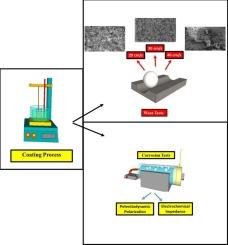Improving the tribological and corrosion behavior of NiB coating with low boron content from optimized lead-free bath on aluminum alloys
IF 6.1
2区 材料科学
Q1 MATERIALS SCIENCE, COATINGS & FILMS
引用次数: 0
Abstract
This study focuses on producing environmentally friendly, lead-free nickel‑boron (Ni![]() B) coatings as an alternative to hard chromium coatings. Using the electroless method, the Ni
B) coatings as an alternative to hard chromium coatings. Using the electroless method, the Ni![]() B coatings were fabricated from a lead-free bath, and the effects of varying B and Ni concentrations on the coatings' chemical composition, surface morphology, hardness, corrosion resistance, and wear performance were investigated. Scanning electron microscopy (SEM) and X-ray diffraction (XRD) were used to analyze surface morphology and phase composition. Corrosion performance was evaluated using potentiodynamic polarization (PP) and electrochemical impedance spectroscopy (EIS), while wear behavior was tested at sliding speeds of 20, 30, and 40 cm/s. The study highlights the critical role of sliding speed on wear mechanisms, friction coefficient, wear rate, and surface morphology. The analyses revealed that the optimal Ni
B coatings were fabricated from a lead-free bath, and the effects of varying B and Ni concentrations on the coatings' chemical composition, surface morphology, hardness, corrosion resistance, and wear performance were investigated. Scanning electron microscopy (SEM) and X-ray diffraction (XRD) were used to analyze surface morphology and phase composition. Corrosion performance was evaluated using potentiodynamic polarization (PP) and electrochemical impedance spectroscopy (EIS), while wear behavior was tested at sliding speeds of 20, 30, and 40 cm/s. The study highlights the critical role of sliding speed on wear mechanisms, friction coefficient, wear rate, and surface morphology. The analyses revealed that the optimal Ni![]() B coating, containing 34 g/L Ni and 3 g/L B, exhibited the highest hardness, the lowest corrosion rate, and the highest wear rate performance. The values obtained from these analyses were 891 HV for hardness, 8.87 × 10−6 mpy for corrosion rate, and 2.21 × 10−4 mm3/N·m for wear rate. The use of analysis of variance (ANOVA) identified key factors influencing these properties. The findings suggest that optimizing boron and nickel concentrations significantly enhances Ni
B coating, containing 34 g/L Ni and 3 g/L B, exhibited the highest hardness, the lowest corrosion rate, and the highest wear rate performance. The values obtained from these analyses were 891 HV for hardness, 8.87 × 10−6 mpy for corrosion rate, and 2.21 × 10−4 mm3/N·m for wear rate. The use of analysis of variance (ANOVA) identified key factors influencing these properties. The findings suggest that optimizing boron and nickel concentrations significantly enhances Ni![]() B coatings' corrosion resistance and wear performance, making them suitable for industrial applications.
B coatings' corrosion resistance and wear performance, making them suitable for industrial applications.

通过优化无铅浴改善铝合金上低硼含量镍铍涂层的摩擦学和腐蚀行为
本研究的重点是生产环保型无铅镍硼(NiB)镀层,以替代硬铬镀层。研究采用无铅镀液,通过无电解法制备了镍硼镀层,并研究了不同浓度的硼和镍对镀层的化学成分、表面形貌、硬度、耐腐蚀性和磨损性能的影响。扫描电子显微镜(SEM)和 X 射线衍射(XRD)用于分析表面形貌和相组成。使用电位极化(PP)和电化学阻抗谱(EIS)评估了腐蚀性能,并在 20、30 和 40 厘米/秒的滑动速度下测试了磨损行为。研究强调了滑动速度对磨损机制、摩擦系数、磨损率和表面形态的关键作用。分析表明,含 34 克/升 Ni 和 3 克/升 B 的最佳 NiB 涂层具有最高的硬度、最低的腐蚀率和最高的磨损率性能。分析得出的硬度值为 891 HV,腐蚀率为 8.87 × 10-6 mpy,磨损率为 2.21 × 10-4 mm3/N-m。利用方差分析(ANOVA)确定了影响这些性能的关键因素。研究结果表明,优化硼和镍的浓度可显著提高镍硼涂层的耐腐蚀性和磨损性能,使其适用于工业应用。
本文章由计算机程序翻译,如有差异,请以英文原文为准。
求助全文
约1分钟内获得全文
求助全文
来源期刊

Surface & Coatings Technology
工程技术-材料科学:膜
CiteScore
10.00
自引率
11.10%
发文量
921
审稿时长
19 days
期刊介绍:
Surface and Coatings Technology is an international archival journal publishing scientific papers on significant developments in surface and interface engineering to modify and improve the surface properties of materials for protection in demanding contact conditions or aggressive environments, or for enhanced functional performance. Contributions range from original scientific articles concerned with fundamental and applied aspects of research or direct applications of metallic, inorganic, organic and composite coatings, to invited reviews of current technology in specific areas. Papers submitted to this journal are expected to be in line with the following aspects in processes, and properties/performance:
A. Processes: Physical and chemical vapour deposition techniques, thermal and plasma spraying, surface modification by directed energy techniques such as ion, electron and laser beams, thermo-chemical treatment, wet chemical and electrochemical processes such as plating, sol-gel coating, anodization, plasma electrolytic oxidation, etc., but excluding painting.
B. Properties/performance: friction performance, wear resistance (e.g., abrasion, erosion, fretting, etc), corrosion and oxidation resistance, thermal protection, diffusion resistance, hydrophilicity/hydrophobicity, and properties relevant to smart materials behaviour and enhanced multifunctional performance for environmental, energy and medical applications, but excluding device aspects.
 求助内容:
求助内容: 应助结果提醒方式:
应助结果提醒方式:


